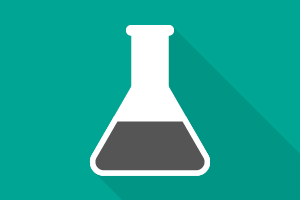Classroom Resources: Chemistry Basics
Filter by:
26 – 50 of 100 Classroom Resources
-

Molecular Structure , Molecular Structure, Molecular Formula, Naming Compounds, Chemical Bond, Interdisciplinary, Introduction | Middle School, High School
Activity: Modeling Carbohydrates Mark as Favorite (18 Favorites)
In this activity, students will identify that organic compounds contain carbon and other elements such as hydrogen and oxygen. They will investigate the structure of different organic and inorganic compounds and model several molecules, including a carbohydrate molecule. They will use their models to help understand how larger molecules are broken down into smaller molecules.
-

Indicators, Interdisciplinary | Middle School, High School
Lab: Exhaling Acid Mark as Favorite (32 Favorites)
In this lab students will observe how increased carbon dioxide levels lead to a build-up of acidic conditions.
-

Temperature, History, Interdisciplinary, Chemical Change, Temperature, Heat | Middle School, High School
Lab: Greenhouse Gas Simulation Mark as Favorite (34 Favorites)
In this lab, students will create two simulations of the Earth’s atmosphere. They will compare a control model with a one that has an increased presence of carbon dioxide gas in order to analyze how this effects temperature. They will also complete research in order to learn more about the makeup of the Earth’s atmosphere.
-

Concentration, Mixtures, Interdisciplinary, Scientific Method, Measurements | Middle School, High School
Lab: Effect of Salt Concentration on Plants Mark as Favorite (10 Favorites)
In this lab, students will observe how salt concentration can affect the structure of a potato tuber.
-

Atomic Spectra, Emission Spectrum, Emission Spectrum, Electromagnetic Spectrum, Interdisciplinary, Identifying an Unknown | Middle School, High School
Lab: Build a Spectroscope Mark as Favorite (28 Favorites)
In this lab, the students will make and use a spectroscope to identify the spectra within various types of light bulbs. The students will then develop an improved design for the spectroscope.
-

Elements, Periodic Table, Interdisciplinary, History, Atoms, Model of the Atom | Middle School, High School
Project: Element Baby Book Mark as Favorite (44 Favorites)
In this activity, students will “adopt” an element and create a baby book about their “new baby” while they research and learn about the element.
-

Introduction, Observations, Interdisciplinary, Scientific Method | Middle School, High School
Activity: Engineering Project Mark as Favorite (5 Favorites)
In this activity, students work together in a small team in order to solve a problem and achieve a common goal. Students will need to work collaboratively in order to be successful. They will be required to communicate their ideas both verbally and in written form, assign duties, design and carry out a procedure in this activity. They will also be challenged with problem solving when/if their original plan fails.
-

Atomic Spectra, Emission Spectrum, Emission Spectrum, Electromagnetic Spectrum, Interdisciplinary, Identifying an Unknown | Middle School, High School
Lab: Spectral Detective Mark as Favorite (36 Favorites)
In this lab, students will use a spectroscope to view the atomic spectra of various unknown elements. Using their collected data in combination with known atomic spectra, they will identify the chemical elements.
-

History, Interdisciplinary, Physical Properties, Chemical Properties, Observations, Mixtures | Middle School, High School
Lab: Top Secret Mark as Favorite (21 Favorites)
In this lab, students will learn about the history of invisible ink and will have the opportunity to compare two types of homemade invisible ink recipes.
-

Electromagnetic Spectrum, Interdisciplinary | Elementary School, Middle School, High School
Activity: Animation Activity: Electromagnetic Spectrum Mark as Favorite (42 Favorites)
In this activity, students will view an animation that explores the electromagnetic spectrum, with a focus on the visible spectrum. The animation addresses the relationship between color, wavelength, frequency, and energy of light waves, as well as how an object absorbs and reflects certain wavelengths of light to contribute to the color we perceive.
-

Electromagnetic Spectrum, Interdisciplinary | Middle School, High School, Elementary School
Animation: The Electromagnetic Spectrum Animation Mark as Favorite (77 Favorites)
This animation explores the electromagnetic spectrum, with a focus on the visible spectrum. It addresses the relationship between color, wavelength, frequency, and energy of light waves, as well as how an object absorbs and reflects certain wavelengths of light to contribute to the color we perceive. This animation was featured in the May 2020 issue of Chemistry Solutions. **This video has no spoken audio**
-

Interdisciplinary, History, Polymers, Polymers, Condensation, Monomer, Monomer, Alloys | High School
Lesson Plan: Synthetic Materials Through History Mark as Favorite (10 Favorites)
In this lesson, students will learn about the history of synthesized materials through reading an article. There are a series of activities to help promote literacy in the science classroom related to the reading. This lesson could be easily used as plans for a substitute teacher, as most of the activities are self-guided.
-

Elements, Periodic Table, Interdisciplinary | Middle School, High School
Activity: Simulation Activity: What Type of Element Are You? Mark as Favorite (41 Favorites)
In this activity, students will take a nine question personality quiz to determine which of four types of elements best matches their personality. They will then have an opportunity to reflect on why their answers led to their final quiz results and to consider what the "personality profile" of other types of elements not included in this quiz might look like.
-

Elements, Interdisciplinary, Periodic Table | Middle School, High School
Simulation: What Type of Element Are You? Mark as Favorite (56 Favorites)
In this simulation, students will take a nine question personality quiz to determine which of four types of elements best matches their personality. The accompanying student activity provides students an opportunity to reflect on why their answers led to their final quiz results and to consider what the "personality profile" of other types of elements not included in this quiz might look like.
-

Molecular Formula, Empirical Formula, History, Interdisciplinary | High School
Activity: Herbal Remedies Mark as Favorite (46 Favorites)
In this activity, students learn how the modern atomic theory evolved. They further their understanding of empirical and molecular formulas through research and a presentation of an herbal remedy.
-

History, Interdisciplinary | High School
Lesson Plan: Marie Maynard Daly Mark as Favorite (10 Favorites)
In this lesson, students will learn about the significant contributions to chemistry by Dr. Marie Maynard Daly, the first Black woman to earn a doctorate in chemistry in the U.S. Students will read an article and engage in related activities that help to promote literacy in the science classroom. Parts of this lesson could be used as plans for a substitute teacher. This lesson provides teachers with strategies to address diversity, equity, and inclusion in the chemistry curriculum.
-

Measurements, Introduction, Dimensional Analysis, Scientific Notation, Error Analysis, Significant Figures, Accuracy, Density, Error Analysis, Interdisciplinary, Accuracy | High School
Lab: Math and Measurement Mark as Favorite (112 Favorites)
In this lab, students will practice introductory math skills that will be used in chemistry all year. This includes metric conversion, significant figures, scientific notation, dimensional analysis, density, percent error, accuracy and precision, as well as using lab equipment.
-

History, Chemical Change, Interdisciplinary | High School, Middle School
Activity: Tie Dye Mark as Favorite (25 Favorites)
In this activity, students make tie-dye shirts and complete a worksheet about a reading from ChemMatters about how dyes work. It gives students the opportunity to apply chemistry to everyday life.
-

Measurements, Graphing, Interdisciplinary | High School
Activity: Modeling Algae Growth Mark as Favorite (2 Favorites)
In this activity, students will read a ChemMatters article about the science of algal blooms to learn how the blooms affect ecosystems. While developing their understanding, students will create a mathematical model to predict algal growth.
-

Interdisciplinary, Photosynthesis | High School
Activity: Algae Trivia Mark as Favorite (3 Favorites)
In this activity, students will participate in a trivia game created in support of the 2023 Chemists Celebrate Earth Week (CCEW) theme, The Curious Chemistry of Amazing Algae. Students will participate individually or as a team to test their knowledge about algae and related chemistry topics.
-

Interdisciplinary | Middle School, High School
Activity: Chemistry Reading Reflection Mark as Favorite (15 Favorites)
In this activity, students will read a short informational science text about chemistry in the real-world (either pre-selected by the teacher, or chosen by the student from a collection of articles) and will briefly summarize and reflect on what they read. This activity could be reused many times with different articles (or even other types of media, like videos) and would be easy to incorporate into a sub plan.
-

Interdisciplinary, Functional Groups, Molecular Structure | High School
Video: Ingenious Video 8: Is the Answer to Overfishing… Algae? Mark as Favorite (3 Favorites)
Omega-3s are an essential nutrient that humans have to get from fish. But many of the world’s wild fish species are in crisis because we’ve taken too many of them from the ocean. So the answer is to farm more of our fish, right? While fish-farming relieves some pressure on the ocean’s wild species, it also contributes to that pressure, since farmed fish are fed fishmeal made from wild-caught fish. That’s because fish don’t make their own Omega-3s either. Like us, they get them from their diet. Using technology that came out of the space program, scientists have developed a way to cut out the middle-fish from the food chain and harvest Omega-3s for fishmeal directly from the source: algae.
-

Interdisciplinary, Functional Groups, Molecular Structure | High School
Activity: Ingenious: Is the Answer to Overfishing… Algae? Video Questions Mark as Favorite (1 Favorite)
In this activity, students will answer questions while watching the video, Is the Answer to Overfishing… Algae? from the Ingenious series produced by the American Chemical Society. Each episode investigates a different topic related to how leading-edge chemistry is taking on the world’s most urgent issues to advance everyone’s quality of life and secure our shared future. This episode investigates Omega-3’s, the essential nutrient that humans have to get from fish. However, fish don’t make their own Omega-3’s, and like humans, must get them from an important part of their diet, algae. But with over-fishing considerations and fish-farming limitations, scientists are working to develop a new way to harvest Omega-3’s to maintain stability.
-

Concentration, Precipitate, Molarity, Molality, Conductivity, Colligative Properties, Boiling Point Elevation, Freezing Point Depression, Distillation, Culminating Project, Graphing, Accuracy, Error Analysis, Interdisciplinary, Mixtures, pH, Buffers, Boiling Point, Freezing Point, Phase Changes | High School
Lesson Plan: Investigating Sea Water Mark as Favorite (27 Favorites)
In this lesson, students will consider their water footprint and means to obtain fresh water from seawater using a solar still. To understand the differences between fresh water and seawater, students will determine the composition of artificial seawater by using qualitative analysis to test for different ions in solution and calculate the molarity of different salts used in the recipe. Students will observe the effects of solutes in aqueous solutions by measuring conductivity and the freezing and boiling points of seawater and deionized water and determine total dissolved solids. In addition, students explore the buffering ability of seawater and the effect of carbon dioxide on its pH.
-

History, Interdisciplinary | High School
Activity: Sustainability Mark as Favorite (14 Favorites)
In this activity, students are introduced to the idea of sustainability by building a vocabulary that they will use and develop through the unit. The subsequent unit focuses on water sustainability, specifically.